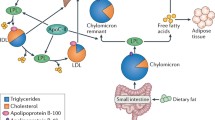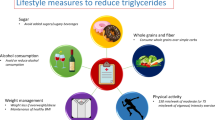Abstract
Purpose of Review
To evaluate recent clinical trials focusing on patients with hypertriglyceridemia.
Recent Findings
Randomized clinical trials have recently been undertaken in hypertriglyceridemic patients to determine whether effective reductions in triglycerides would improve cardiovascular disease (CVD) outcomes. However, the fibric acid derivative, pemafibrate, failed to reduce cardiovascular events despite significant reductions (~ 25–35%) in triglyceride levels and despite background statin therapy. In contrast, icosapent ethyl, a highly purified omega-3 fatty acid was previously shown to reduce CVD events in hypertriglyceridemic patients, despite more modest reductions (~ 20%) in triglyceride levels in statin treated patients.
Summary
The divergent results obtained in patients with hypertriglyceridemia (HTG), a group at particularly high risk of CVD, especially when coupled with other risk factors, indicates that triglyceride lowering in of itself is insufficient to offset CVD risk. Rather, the effectiveness of therapy in this high-risk cohort may be the result of the suppression of the inherent atherogenic properties associated with HTG.

Similar content being viewed by others
References
Papers of particular interest, published recently, have been highlighted as: • Of importance •• Of major importance
Reiner Ž. Hypertriglyceridaemia and risk of coronary artery disease. Nat Rev Cardiol. 2017;14:401–11.
Miller M. Is hypertriglyceridaemia an independent risk factor for coronary heart disease? The epidemiological evidence Eur Heart J. 1998;19(Suppl):H18-22.
Pollin TI, Damcott CM, Shen H, Ott SH, Shelton J, Horenstein RB, et al. A null mutation in human APOC3 confers a favorable plasma lipid profile and apparent cardioprotection. Science. 2008;322:1702–5.
Jørgensen AB, Frikke-Schmidt R, Nordestgaard BG, Tybjærg-Hansen A. Loss-of-function mutations in APOC3 and risk of ischemic vascular disease. N Engl J Med. 2014;371:32–41.
Imke C, Rodriguez BL, Grove JS, McNamara JR, Waslien C, Katz AR, et al. Are remnant-like particles independent predictors of coronary heart disease incidence? The Honolulu Heart study. Arterioscler Thromb Vasc Biol. 2005;25:1718–22.
Miller M, Stone NJ, Ballantyne C, Bittner V, Criqui MH, Ginsberg HN, et al. Triglycerides and cardiovascular disease: a scientific statement from the American Heart Association. Circulation. 2011;123:2292–333.
Triglyceride Coronary Disease Genetics Consortium and Emerging Risk Factors Collaboration, Sarwar N, Sandhu MS, Ricketts SL, Butterworth AS, Di Angelantonio E, et al. Triglyceride-mediated pathways and coronary disease: collaborative analysis of 101 studies. Lancet. 2010;375:1634–9.
Miller M, Cannon CP, Murphy SA, Qin J, Ray KK, Braunwald E, PROVE IT-TIMI 22 Investigators. Impact of triglyceride levels beyond low-density lipoprotein cholesterol after acute coronary syndrome in the PROVE IT-TIMI 22 trial. J Am Coll Cardiol. 2008;51:724–30.
Mautner SL, Lin F, Mautner GC, Roberts WC. Comparison in women versus men of composition of atherosclerotic plaques in native coronary arteries and in saphenous veins used as aortocoronary conduits. J Am Coll Cardiol. 1993;21:1312–8.
Miller M, Bachorik PS, McCrindle BW, Kwiterovich PO Jr. Effect of gemfibrozil in men with primary isolated low high-density lipoprotein cholesterol: a randomized, double-blind, placebo-controlled, crossover study. Am J Med. 1993;94:7–12.
Miller M. Niacin as a component of combination therapy for dyslipidemia. Mayo Clin Proc. 2003;78:735–42.
ACCORD Study Group, Ginsberg HN, Elam MB, Lovato LC, Crouse JR III, et al. Effects of combination lipid therapy in type 2 diabetes mellitus. N Engl J Med. 2010;362:1563–74.
•• Das Pradhan A, Glynn RJ, Fruchart JC, MacFadyen JG, Zaharris ES, Everett BM, et al. N Engl J Med. 2022;387:1923–1934. In this double-blind, randomized, placebo-controlled study of patients with Type 2 diabetes, mild to moderate hypertriglyceridemia (200–499 mg/dL) and low HDL-C (less than or equal to 40 mg/dL) and moderate-high statin use, 0.2 mg of pemafibrate twice daily did not reduce the incidence of CVD, despite significant reductions in TG, VLDL cholesterol and remnant cholesterol.
Duell PB, Welty FK, Miller M, Chait A, Hammond G, Ahmad Z, et al. Nonalcoholic Fatty Liver Disease and Cardiovascular Risk: A Scientific Statement From the American Heart Association. Arterioscler Thromb Vasc Biol. 2022;42:e168–e185.
Bhatt DL, Steg PG, Brinton EA, Jacobson TA, Miller M, Tardif JC, et al. Rationale and design of REDUCE-IT: Reduction of Cardiovascular Events with Icosapent Ethyl-Intervention Trial. Clin Cardiol. 2017;40:138–148.
Olshansky B, Chung MK, Budoff MJ, Philip S, Jiao L, Doyle RT, et al. Mineral oil: safety and use as placebo in REDUCE-IT and other clinical studies. Eur Heart J Suppl. 2020;22:J34–48.
Bhatt DL, Steg PG, Miller M, Brinton EA, Jacobson TA, Ketchum SB, et al. Reduction with Icosapent Ethyl for Hypertriglyceridemia. N Engl J Med. 2019;380:11–22.
Bhatt DL, Steg PG, Miller M, Brinton EA, Jacobson TA, Jiao L, et al. Reduction in First and Total Ischemic Events With Icosapent Ethyl Across Baseline Triglyceride Tertiles. J Am Coll Cardiol. 2019;74:1159–1161.
Gaba P, Bhatt DL, Steg PG, Miller M, Brinton EA, Jacobson TA, et al. Prevention of Cardiovascular Events and Mortality With Icosapent Ethyl in Patients With Prior Myocardial Infarction. J Am Coll Cardiol. 2022;79:1660–1671.
Verma S, Bhatt DL, Steg PG, Miller M, Brinton EA, Jacobson TA, et al; REDUCE-IT Investigators. Icosapent Ethyl Reduces Ischemic Events in Patients With a History of Previous Coronary Artery Bypass Grafting: REDUCE-IT CABG. Circulation. 2021;144:1845–1855.
Peterson BE, Bhatt DL, Steg PG, Miller M, Brinton EA, Jacobson TA, et al. Treatment With Icosapent Ethyl to Reduce Ischemic Events in Patients With Prior Percutaneous Coronary Intervention: Insights From REDUCE-IT PCI. J Am Heart Assoc. 2022;11:e022937.
Selvaraj S, Bhatt DL, Steg PG, Miller M, Brinton EA, Jacobson TA, et al. Impact of Icosapent Ethyl on Cardiovascular Risk Reduction in Patients With Heart Failure in REDUCE-IT. J Am Heart Assoc. 2022;11:e024999.
Majithia A, Bhatt DL, Friedman AN, Miller M, Steg PG, Brinton EA, et al. Benefits of Icosapent Ethyl Across the Range of Kidney Function in Patients With Established Cardiovascular Disease or Diabetes: REDUCE-IT RENAL. Circulation. 2021;144:1750–9.
• Miller M, Bhatt DL, Steg PG, Brinton EA, Jacobson TA, Jiao L, et al. Potential effects of icosapent ethyl on cardiovascular outcomes in cigarette smokers: REDUCE-IT smoking. Eur Heart J Cardiovasc Pharmacother. 2023;9:129–137. In this post-hoc analysis of the REDUCE-IT study, treatment with the purified EPA compound, cigarette smokers who were randomized to Icosapent Ethyl, exhibited a similarly reduced risk of CVD as non-smokers assigned to placebo.
• Ridker PM, Rifai N, MacFadyen J, Glynn RJ, Jiao L, Steg PG, et al. Effects of Randomized Treatment With Icosapent Ethyl and a Mineral Oil Comparator on Interleukin-1β, Interleukin-6, C-Reactive Protein, Oxidized Low-Density Lipoprotein Cholesterol, Homocysteine, Lipoprotein(a), and Lipoprotein-Associated Phospholipase A2: A REDUCE-IT Biomarker Substudy. Circulation. 2022;146:372–379. Biomarker levels of inflammation (e.g., interleukin-6, lipoprotein-associated phospholipase A2, high-sensitivity C-reactive protein, and interleukin-1β increased in the placebo group that consistent of pharmaceutical grade mineral oil. However, the clinical relevance of these findings is low because despite elevations, biomarker levels remained within normal range.
Yokoyama M, Origasa H, Matsuzaki M, Matsuzawa Y, Saito Y, Ishikawa Y, et al. Effects of eicosapentaenoic acid on major coronary events in hypercholesterolaemic patients (JELIS): a randomised open-label, blinded endpoint analysis. Lancet. 2007;369:1090–8.
Watanabe T, Ando K, Daidoji H, Otaki Y, Sugawara S, Matsui M, et al. A randomized controlled trial of eicosapentaenoic acid in patients with coronary heart disease on statins. J Cardiol. 2017;70:537–544.
Nicholls SJ, Lincoff AM, Garcia M, Bash D, Ballantyne CM, Barter PJ, et al. Effect of High-Dose Omega-3 Fatty Acids vs Corn Oil on Major Adverse Cardiovascular Events in Patients at High Cardiovascular Risk: The STRENGTH Randomized Clinical Trial. JAMA. 2020;324:2268–80.
Khan SU, Lone AN, Khan MS, Virani SS, Blumenthal RS, Nasir K, et al. Effect of omega-3 fatty acids on cardiovascular outcomes: A systematic review and meta-analysis. EClinicalMedicine. 2021;38: 100997.
Sniderman AD, Thanassoulis G, Glavinovic T, Navar AM, Pencina M, Catapano A, Ference BA. Apolipoprotein B Particles and Cardiovascular Disease: A Narrative Review. JAMA Cardiol. 2019;4:1287–95.
Carr SS, Hooper AJ, Sullivan DR, Burnett JR. Non-HDL-cholesterol and apolipoprotein B compared with LDL-cholesterol in atherosclerotic cardiovascular disease risk assessment. Pathology. 2019;51:148–54.
Mason RP, Libby P, Bhatt DL. Emerging Mechanisms of Cardiovascular Protection for the Omega-3 Fatty Acid Eicosapentaenoic Acid. Arterioscler Thromb Vasc Biol. 2020;40:1135–47.
Ahmad Z, Banerjee P, Hamon S, Chan KC, Bouzelmat A, Sasiela WJ, Pordy R, Mellis S, Dansky H, Gipe DA. Dunbar RL Inhibition of Angiopoietin-Like Protein 3 With a Monoclonal Antibody Reduces Triglycerides in Hypertriglyceridemia. Circulation. 2019;140:470–86.
Gaudet D, Alexander VJ, Baker BF, Brisson D, Tremblay K, Singleton W, Geary RS, Hughes SG, Viney NJ, Graham MJ, Crooke RM, Witztum JL, Brunzell JD, Kastelein JJ. Antisense Inhibition of Apolipoprotein C-III in Patients with Hypertriglyceridemia. N Engl J Med. 2015;373:438–47.
•• Bhatt DL, Bays HE, Miller M, Cain JE III, Wasilewska K, Andrawis NS, Parli T, et al. The FGF21 analog pegozafermin in severe hypertriglyceridemia: a randomized phase 2 trial. ENTRIGUE Principal Investigators. Nat Med. 2023. https://doi.org/10.1038/s41591-023-02427-z. Online ahead of print. In this Phase 2 Trial of 85 men and women with SHTG, the fibroblast growth factor 21, pegozafermin injected subcweekly (or twice monthly) for 8 weeks, significantly reduced TG (40–60%), non-HDL-C (20–30%), apoB (10–20%) and the liver fat fraction by 40%. As such, it is the first study to demonstrate reduction of liver fat in patients with SHTG.
Skretteberg PT, Grytten AN, Gjertsen K, Grundvold I, Kjeldsen SE, Erikssen J, et al. Triglycerides-diabetes association in healthy middle-aged men: modified by physical fitness? A long term follow-up of 1962 Norwegian men in the Oslo Ischemia Study. Diabetes Res Clin Pract. 2013;101:201–9.
Miller M, Beach V, Sorkin JD, Mangano C, Dobmeier C, Novacic D, et al. Comparative effects of three popular diets on lipids, endothelial function, and C-reactive protein during weight maintenance. J Am Diet Assoc. 2009;109:713–7.
Park JE, Miller M, Rhyne J, Wang Z, Hazen SL. Differential effect of short-term popular diets on TMAO and other cardio-metabolic risk markers. Nutr Metab Cardiovasc Dis. 2019;29:513–7.
Miller M, Sorkin JD, Mastella L, Sutherland A, Rhyne J, Donnelly P, et al. Poly is more effective than monounsaturated fat for dietary management in the metabolic syndrome: The muffin study. J Clin Lipidol. 2016;10:996–1003.
Sacks FM, Lichtenstein AH, Wu JHY, Appel LJ, Creager MA, Kris-Etherton PM, et al; American Heart Association. Dietary Fats and Cardiovascular Disease: A Presidential Advisory From the American Heart Association. Circulation. 2017;136:e1–e23.
Funding
Funded in part by a VA Merit Award to Dr. Miller.
Author information
Authors and Affiliations
Corresponding author
Ethics declarations
Conflict of Interest
Dr. Miller is a scientific advisor for Amarin, Inc. and 89bio. Dr. Chukwurah declares no conflict of interest.
Human and Animal Rights and Informed Consent
This article does not contain any studies with human or animal subjects performed by any of the authors.
Additional information
Publisher's Note
Springer Nature remains neutral with regard to jurisdictional claims in published maps and institutional affiliations.
This article is part of Topical Collection on Lipid Abnormalities and Cardiovascular Prevention
Rights and permissions
About this article
Cite this article
Chukwurah, M.I., Miller, M. Fibrates, Hypertriglyceridemia, and CVD Risk: Where Do We Stand After the PROMINENT Trial for Triglyceride Lowering?. Curr Cardiol Rep 25, 987–992 (2023). https://doi.org/10.1007/s11886-023-01926-2
Accepted:
Published:
Issue Date:
DOI: https://doi.org/10.1007/s11886-023-01926-2




